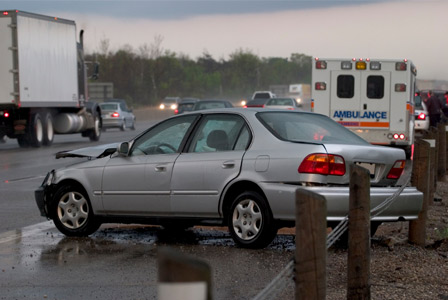
Today, 90 people in the U.S. will get in their cars, give their sweetheart a kiss and drive off, not knowing this is the day they will die in a traffic accident. Don't be one of them. The next time you buckle up, keep these expert driving tips in mind.
How to drive to
stay alive
Put your cell phone in your trunk
"We all like to think that we won't text or take calls when we're driving," says Kyle S. Reyes, director of marketing at the Carter of Manchester dealership, "but we also like to think we won't eat an ice cream sundae if it's in front of us." Even if you shut off your phone, you'll be tempted to turn it on. Texting while driving has been shown to be even more dangerous than drunk driving, so remove the temptation.
Minimize distractions
"The number-one thing you can do to avoid car accidents has nothing to do with technology, vehicle safety features or even seat belts," says Lee Ann Shattuck, co-owner and chief car chick of Women's Automotive Solutions. "It's very simple — pay attention! Driving is an activity that requires your full attention, so try to minimize the distractions. Constantly look around and check your mirrors so you know what's going on around you and what other drivers are doing. Be sure to look ahead down the road, not just at the car in front of you. Being able to see potential dangers well before they happen gives you time to take action to avoid the situation, not just react when the problem is right in front of you."
Don't be a tailgater
"Do not use 'car lengths' to gauge your following distance," says Eddie Wren, president and chief instructor, Advanced Drivers of America. "That method was invented by foolish guesswork and has always been absurdly inadequate. Watch the vehicle ahead of you as it passes something or crosses a shadow or a change in color of the asphalt, then leave three seconds' gap on a dry road, six seconds on a very wet road, and 12 — yes, 12 — seconds on an icy or very slippery road."
Don't make a lasagna your co-pilot
Avoid putting loose objects in the front seat. "The problem isn't that you're going to slam on the brakes and it will go flying," says Reyes. "The problem is that if it goes flying, you'll be more concerned about stopping it from going all over the floor than you will be concerned about following through with properly avoiding whatever obstacle you had to brake for in the first place. Our natural reaction is often to catch things — we are used to it. We aren't used to avoiding a cow in the road."
Slow down
"Excessive speed is a factor in approximately 30 to 35 percent of all fatal crashes," says Wren. Even if you avoid an accident while speeding, blowing past the speed limit puts you at risk for a speeding ticket, a huge fine and spending a beautiful spring day inside at driving school.
Don't be one of those people
"If you are at or below the speed limit, get out of the passing lane," says Reyes. "In many states it's actually illegal to travel in the passing lane." Plus, you're not going to make any friends by blocking traffic in the fast lane.
Hand over the keys
"When it comes to alcohol and driving, the safest limit is zero!" says Wren. Reyes adds, "As we know, when you drink your judgment goes out the window. Think about those times you ended up kissing an ugly stranger or riding a mechanical bull. I'll bet it's not something you would do sober. So after you've started drinking, hand over your keys — because your sober self would have more brains than to drive drunk."
Maintain your tires
Worn or under-inflated tires can lead to hydroplaning, skidding and even fatal rollovers. Check your tires monthly and make sure they're inflated according to your manufacturer's recommendations and have at least 1/16 of an inch tread depth. New tires can be a big expense, but replace them when needed for your own safety.
Don't nap and drive
"I've used every trick from singing bad country songs to sticking my hand out the window and then sticking it down the back of my neck," says Paul Balich, instructor at Skip Barber School of Racing. "The best thing is to just pull over and take a 20-minute nap."
Protect what's behind you
Always check behind your vehicle before reversing, especially if you have small children. Check out this clever street art campaign from Toyota Belgium reminding drivers of the risk of injuring or killing children when they're playing behind vehicles.
More safe driving tips
The how and why of rollovers
How to recover from a skid
How to stop a hydroplane